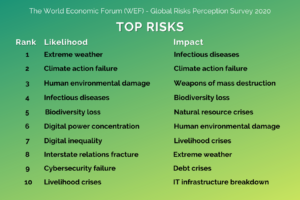
Since 2020, Environmental, Social and Governance (ESG) has become a hot button issue, with representatives of governments, businesses, and other organizations committed to supporting the objective of the Paris Agreement. It is a call on the asset management industry to adopt minimum standards in support of those objectives to achieve the goals of that Paris Agreement.
Canadian Boards of Directors and CEOs need to take note the federal banking regulator has recently put financial institutions on notice to prove they can be trusted to adequately adjust for the risks posed by climate change. If they don’t they’ll be mandated to keep more capital in their rainy-day funds. The federal regulator views this as appropriate because capital is no substitute for risk management. In the near term, risk management needs to be in place, and in the longer term, once that matures, it will move into the capital arena.
Therefore, the biggest financial institutions should heed the advice as they’re being offered a window to confront climate change on their own terms and thus be able to avoid onerous capital requirements if they’re applying the same strict standards to climate risk as they apply to small-business loans.
These financial institutions will in turn, eventually, require small and medium enterprises (SMEs) to apply robust risk management to avoid onerous capital losses at all levels of business, promote good governance, affect performance/stewardship, and ethical business practices.
NASDAQ launched in May 2019 its Voluntary Support Program for Companies, a new global ESG reporting guide for public and private companies. The Guide’s purpose is two-fold: (1) to enable companies to provide fair, transparent, and efficient markets for all stakeholders; and (2) to emphasize that ESG practices can be as beneficial to individual companies as they are to their investors.
According to the CPA Canada Sustainability – ESG Framework Resource, ESG factors play a key role in an organization’s ability to deliver results by creating value for all stakeholders, not just shareholders. Using the ESG lens to view an organization can help identify and quantify the impact of non-financial issues that will have a material financial impact on its short and long-term value. The organization’s issues include an impact on the environment or vice versa, talent management and employee diversity, governance, data security, health, and safety.
In an informative article in the Harvard Business Review on January 10, 2022, Dambisa Moyo outlined the following ten questions that companies need to answer concerning its ESG strategy:
1. Is ESG undermining your company’s competitiveness?
2. Does driving the ESG agenda mean sacrificing company returns?
3. How are you navigating ESG trade-offs?
4. How does ESG change due diligence?
5. Should you become a public benefit corporation?
6. How should corporations address societal concerns such as racial equity?
7. How do you develop a global approach to ESG?
8. How do you build an ESG framework that is future-proofed for tomorrow’s economic realities?
9. How do you vet company performance of ESG?
10. How should corporations navigate the ever-changing landscape of ESG?
Reviewing ESG issues in a holistic manner and using appropriate ESG metrics can help the organization:
- Recognize when its strategies need an overhaul;
- Identify which practices associate with its key future risks and how they can be developed into opportunities for competitive advantage, to either protect or generate value to its shareholders and stakeholders, and
- Reassure investors that it is thinking ahead, so that they continue to invest in it.
To summarize, the organization should have an ESG statement of purpose clearly stated on their digital footprint and that it’s communicated to its stakeholders and regulators, where applicable. This statement should be supported with appropriate metrics and a robust reporting mechanism.
Awad Loubani
Senior Advisor



